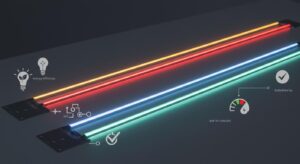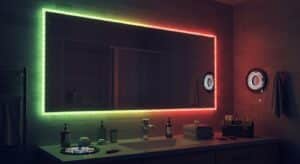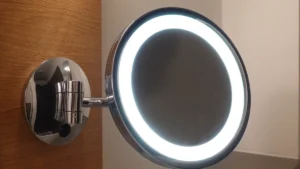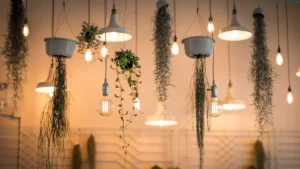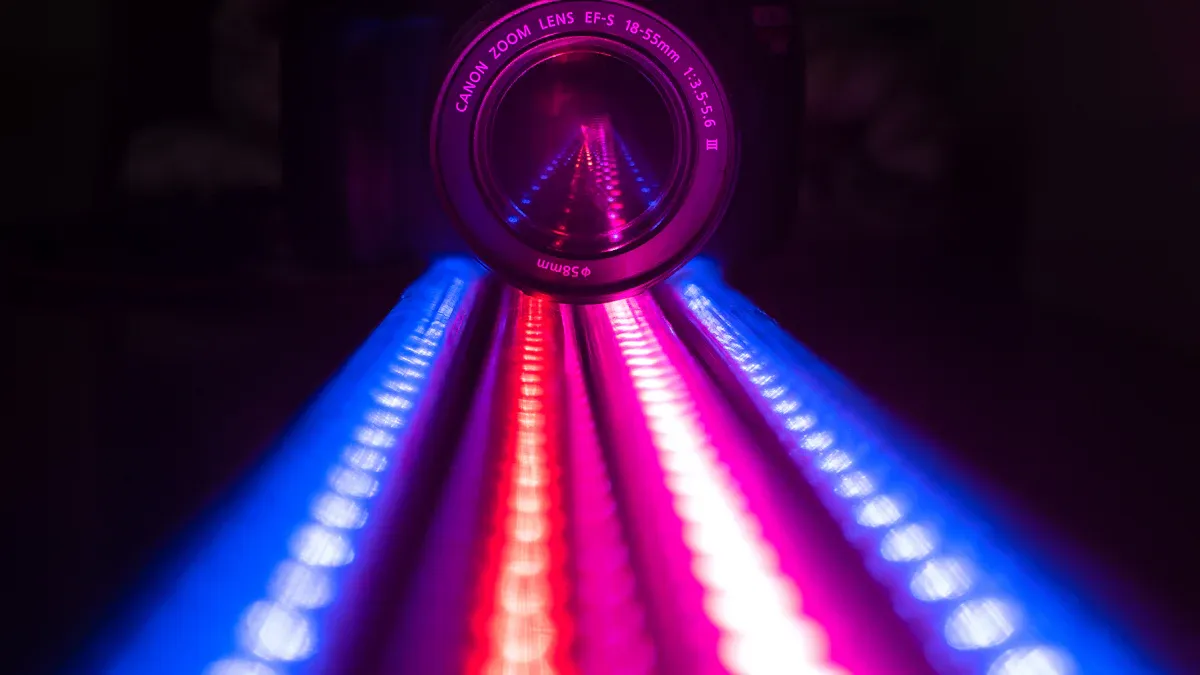
A led lens is a part that changes LED light. It helps to shape, focus, or spread the light as needed. The job of led lenses is to manage how light spreads. This makes lighting systems work better and look nicer.
Key Takeaways
LED lenses change and direct light, making it work better and look nicer in many lighting setups.
Picking the correct lens material and design can make light clearer, use less energy, and lower expenses.
Special LED lenses are made for certain uses, giving the best brightness and ease in various places.
Types of LED Lenses
Material-Based Categorisation
The material of a led lens is very important. It affects how well the lens works and how long it lasts. Different materials offer unique advantages:
PMMA (Polymethyl Methacrylate): These lenses let through up to 92% of light. They are also much stronger than regular glass, resisting impacts 7-10 times better.
PC (Polycarbonate): These lenses allow 89% light through but work at 99% efficiency.
Silicone: Silicone lenses are bendy and can handle very hot or cold conditions. This makes them great for tough environments.
Glass: Glass lenses are very clear and strong but heavier. They also break more easily than other materials.
Tip: Pick the right lens material based on the environment, cost, and how efficient you want it to be.
Lens Type | Light Transmittance (%) | Optical Efficiency (%) |
|---|---|---|
PMMA | 90-92 | 92 |
PC | 89 | 99 |
Design and Shape Variations
The shape of a led lens changes how light spreads. New designs now make light brighter and colours look better. Common shapes include:
Convex Lenses: These focus light into a small, bright spot. They are good for task lighting and spotlights.
Concave Lenses: These spread light over a large area, perfect for soft room lighting.
Asymmetric Lenses: These direct light unevenly, ideal for streetlights where even coverage is needed.
Custom shapes help aim light exactly where it’s needed. This saves energy and reduces wasted light, especially in places like offices or shops.
Note: Choosing the right lens shape can make your lighting system work better and look nicer.
Customised Lenses for Specific Applications
Custom led lenses are made for special lighting needs in different places. For example, in reading areas, lenses are designed to give the best brightness and colour. This helps people read better and feel less tired.
Reading Duration | Illuminance (lux) | Colour Temperature (K) | Benefits |
|---|---|---|---|
15 minutes | 500 | 6500 | Better reading, less eye strain |
30 minutes | 500 | 4000 | Better reading, less eye strain |
60 minutes | 750 | 6500 | Better reading, less eye strain |
Custom lenses are also used in factories and outdoor lights. They are built to handle tough conditions while giving precise light. By designing lenses for specific uses, you can save energy and get better results.
Benefits of LED Lenses
Energy Efficiency and Cost Savings
LED lenses help save energy by spreading light better. This cuts down on wasted energy and lowers electricity costs. For example:
LED lights use 70% less energy than older lights.
Adding TIR (Total Internal Reflection) and smart controls can reduce energy use in offices by 62%.
These savings make LED lenses a smart choice for homes and businesses. They improve lighting efficiency, save money over time, and lower your carbon footprint.
Better Light Quality and Spread
LED lenses make light clearer by focusing or spreading it. This gives even brightness and removes sharp shadows. Things like Colour Rendering Index (CRI) and colour temperature are important for user comfort. For example:
Metric Type | What It Means |
|---|---|
Energy Efficiency Metrics | Shows how much energy is saved and where energy is lost. |
Consumer Experience Metrics | Includes CRI and colour temperature, which affect how people feel about the light. |
The right lens can make spaces look nice and feel comfortable, whether at home or work.
Strong and Long-Lasting
LED lenses are built to last and handle tough conditions. They are tested to meet high standards:
Metric/Standard | What It Means |
|---|---|
Lumen Depreciation | How brightness slowly fades over time, showing how long LEDs last. |
L70 Rating | The point when LEDs give 70% of their original brightness. |
Expected Lifespan | Regular LEDs last 25,000 to 50,000 hours, while top ones last up to 100,000 hours. |
This strength means fewer repairs and steady lighting for a long time.
Works in Many Lighting Systems
LED lenses can be used in many places. They fit industrial, commercial, and home lighting needs:
Application Sector | What It’s Used For |
|---|---|
Industrial | Used in factories and mines for safety signals and warnings. |
Commercial | Used in shops, offices, and hospitals for emergency lights and decoration. |
Residential | Used at home for safety, like garden and driveway lights, often with smart home systems. |
This flexibility makes LED lenses useful for all kinds of lighting setups, giving great results everywhere.
Applications of LED Light Lenses
Residential and Commercial Lighting
LED lenses are important for better home lighting. They spread light evenly, making rooms cosy and nice to look at. For example:
In living rooms or bedrooms, they remove harsh shadows.
In kitchens or study areas, they focus light for better visibility.
Using LED lenses at home saves energy and lowers bills. They also last longer than old-style lights.
In offices, shops, and hospitals, LED lenses are very useful. They direct light to work desks or shelves, improving focus. This helps workers be more productive and makes products stand out in shops. Businesses save money with these lenses because they use less energy. By 2031, the LED lens market is expected to grow a lot, showing their rising popularity.
Automotive and Street Lighting
LED lenses have changed car lighting systems. They make headlights brighter and clearer, helping drivers see better. A study showed LED headlights work best in foggy weather. They also make taillights and indicators clearer, reducing accidents.
For streetlights, LED lenses spread light evenly on roads and paths. This makes streets safer without wasting energy. LED streetlights last longer, need less fixing, and save money for cities. Their smart designs make urban areas safer and greener.
Feature | Description |
|---|---|
Energy Efficiency | LEDs use less power by turning electricity into light. |
Lifespan | LED streetlights last longer than older lighting types. |
Design Technology | New designs improve how well they work and save energy. |
Industrial and Outdoor Lighting
LED lenses are great for factories and outdoor spaces. In factories, they light up work areas like assembly lines. This keeps workers safe and helps them work better. These lenses can handle tough conditions like heat and vibrations.
For outdoor spaces like parks or stadiums, LED lenses spread light evenly over big areas. This improves safety and reduces wasted light. They are strong, save energy, and cost less to maintain. This makes them perfect for outdoor lighting.
LED lenses are useful in many places. Whether at home, work, or outside, they make lighting better and save energy. They are a key part of modern lighting systems.
Future Trends in LED Lens Technology
Smart Lighting Integration
Smart systems are changing how LED lights work. These systems, called smart lighting, connect to IT networks. They make lighting more efficient and useful. For example, smart street lights use IoT devices to check weather, daylight, and movement. This improves safety and saves energy, making them very eco-friendly.
In offices and shops, smart LED lights with special lenses adjust brightness. They change based on what people are doing. This shows how led lenses help create flexible and responsive lighting setups.
Sustainable Materials in Lens Design
More people want eco-friendly materials for led lenses. Companies are looking for better options than PMMA and PC lenses. Silicone is one good choice. It works well and is kinder to the environment.
Governments are pushing for lower emissions, encouraging green lighting solutions. Picking lenses made from sustainable materials helps the planet. You can still get great lighting without harming the environment.
Precision Optical Advancements
New optical technology is improving led lenses. Lenses like the 20X Microscope Lens help check tiny LED parts. They make light clearer and work better. When used with ProMetric® Imaging Photometers, they test LEDs faster and more accurately.
These upgrades make led lighting systems perfect for places needing top-quality light. The market for led lenses is growing fast, with big changes expected by 2033. Exciting new ideas will keep improving lighting technology.
Tip: Learn about new led lens technologies to choose the best lighting for your needs.
LED lenses are important for modern lighting systems. They spread light better, save energy, and last longer. These lenses can be used in many places, like homes and factories.
The UK LED lighting market will grow from 1.35 billion USD in 2025 to 1.72 billion USD by 2030. This shows people want LED lights more and more.
Outdoor LED lighting in public spaces will make up 81% of the market by 2024.
New ideas like smart systems and eco-friendly materials will change lighting. These improvements will make lights work even better and more accurately.
FAQ
What are LED lenses, and why do they matter?
LED lenses help shape and control the light from LEDs. They spread light better, save energy, and improve lighting for many uses.
How are LED lenses different from old-style lenses?
LED lenses are made to work well with LEDs. They last longer, save more energy, and control light better than older lenses.
Can LED lenses be used in home lighting?
Yes, LED lenses work great for homes. They make rooms feel warm, use less energy, and last a long time, making them a smart choice.
See Also
A Comprehensive Guide to RGB LED Modules in 2025
Current Innovations in Edgelight LED Technology Explored
An Insight into How COB LED Strips Function
